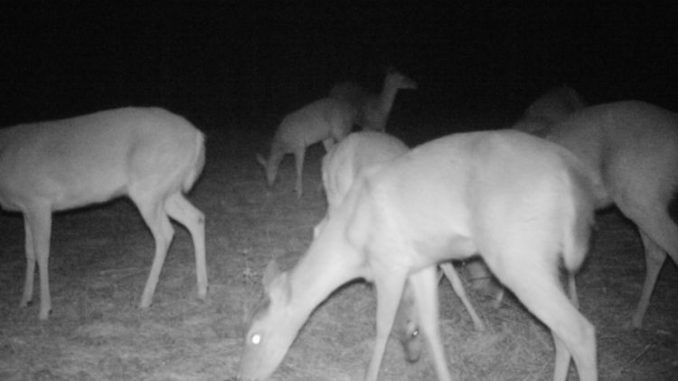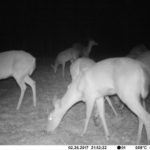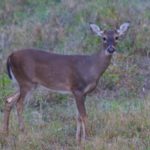
Poor habitat conditions, hogs, storms all contribute
Many years ago, in the mid-70s, there was an article in a popular hunting magazine that was titled “The Thundering Herd.” Basically it was about exploding deer numbers in most of the states in the southeast. Following deer restocking and limited bucks-only hunting along with improved habitat conditions, deer populations began to expand and numbers increased dramatically. Hunters had done a good job of protecting does and now their numbers were increasing in most states, including the Bayou State.
As a response to these growing deer numbers wildlife agencies began increasing the number of doe days. Louisiana hunters had been reluctant to participate in them in the 1950s and this attitude had not changed. After all, everyone knows that the does are the ones producing the bucks, and it was well ingrained in our hunters that one does not shoot does except when some camp meat is needed. In the early 80s the DMAP program was initiated by LDWF and clubs and landowners finally started shooting does. One of the problems was that they also continued pounding the bucks and the age structure of the male population began to decline. Thus hunters began to cry that shooting does was not working to improve buck quality. One of the goals of either-sex hunting is to keep the herd in balance with available habitat providing nutrition necessary for good body growth and antler development. Of course the real problem was that most herds consisted of high numbers of 1 ½-year-old bucks with few being adults. Finally the idea of managing the harvest, both bucks and does, began to catch on. As this occurred the state moved in the direction of full season either-sex days statewide. Every day of the season was now a doe day and many hunters blamed this for declining deer numbers. At about this same time deer tagging began along with a season limit of three does and three bucks. The DMAP program continued, but many clubs and landowners opted for the general statewide seasons to manage their harvest. It should be noted that clubs and landowners were advised from day one that the harvest needed to be regulated and controlled, particularly the doe harvest.
Unfortunately about this same time changes in the landscape began to take their toll on the deer habitat. In the piney woods, changes really began to have an impact on the forested habitat. Clear-cuts that once produced abundant browse were now being treated with herbicides that killed the woody vegetation to eliminate the competition with the pines. Body growth and antler development was impacted along with productivity.
Feral hog numbers began to increase and expand across the state due to hunters releasing them on areas with the idea of having another animal to hunt. Hogs have had an impact on both the deer habitat and the deer. Research has found that hogs spread diseases which also impact deer productivity.
In southeast Louisiana, in the piney woods of the Florida Parishes and in the coastal swamps and marshes, a series of severe storms wreaked havoc on the landscape. In the rural landscape of the Florida Parishes, urbanization and human development greatly increased as people began to relocate from southern parishes, further impacting the wildlife habitat.
All of these factors have worked together to impact some of the state’s deer herds, especially in Areas 4 and 9. In recent years these two areas have gone back to doe days in an effort to reduce the harvest of does. The northwest parishes continue to lead the way in total number of deer harvested and continue to have the full either-sex deer seasons. Union, Bienville, Vernon, Claiborne, Natchitoches, Bossier, Jackson and Winn are listed in the Top 10. The parishes of Tensas and Madison represent the bottomland hardwood habitat in this list of top deer harvest parishes. At one time some of the southeastern parishes were in the Top 20 list but now have dropped below the top parishes.
I asked Johnathan Bordelon, LDWF Deer Program Manager, about the issue of declining deer numbers and the management work being done to offset it. His data from the state Annual Harvest Survey, DMAP and WMA harvest data along with data from the reported tag harvest indicates a significant decline in the state harvest since the 2008 season. Since the late 90s, harvest data trends developed from the annual harvest survey have been on the decline from a high of 200,000+ to less than 150,000. A reduced deer harvest on the wildlife management areas has also been observed, but hunter participation has also declined. Some areas still continue to have good numbers; for instance on Boeuf WMA in 2016 there were 315 deer harvested on the managed hunts for a hunter effort of one deer per 4.6 efforts, which is excellent. On Pearl River, the area I hunt, there was one deer killed per 52 hunter efforts, which is pretty poor. However, the hunters on Pearl have really dropped and we all know that the number of hunters hunting on a day along with weather conditions have a dramatic impact on hunter success.
Bordelon pointed out that it is difficult to determine what impact the return to doe days had on the deer populations in these areas but the harvest remained low. Many hunters did not like these doe days and wanted to return to full season either-sex. For this season, LDWF has initiated a quota limit for these areas along with the return of a full either-sex season; hunters in these areas can legally harvest one buck, one doe and one either-sex deer for a three deer limit. The harvest survey data indicated that successful hunters killed 1 to 3 deer, so the three-deer limit was chosen. This limit also applies to the public lands located within these areas. Again, the idea is to reduce the deer harvest, especially the doe harvest.
The big unknown in these areas that have experienced a reduction in the deer population is whether or not they can actually support an increase in deer numbers following all the changes that have occurred over the past 20 years. Habitat, good or bad, can only support so many deer. An increase in deer numbers on low quality habitat is going to produce low quality deer. Hunters will really have to become involved with the deer management program in order to improve both habitat and herd. Clubs and landowners with sufficient acreage would benefit from involvement with DMAP. Reduced deer numbers on small clubs and private lands may simply be the new trend that hunters have to adjust to.




